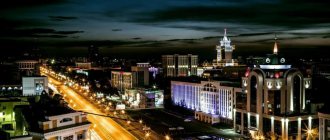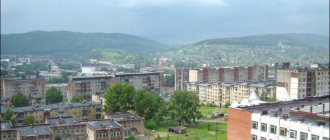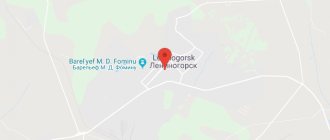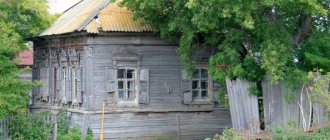Veliky Novgorod was built in the Preilmenskaya lowland on the coast of the Volkhov River. The distance to Moscow is more than 500 kilometers, and to St. Petersburg - within 200 kilometers. Veliky Novgorod is considered the most ancient city, its foundation dates back to 859.
Today the population of Veliky Novgorod is 224,297 people. While in 2022 it was 222,868 people. The demographic situation is ambiguous: there are wave-like surges of growth and decline. The population density at the beginning of 2019 was 2405.6 people per square meter. Residents of Veliky Novgorod are called Novgorodians, Novgorodets, Novgorodka.
On average, the population of Veliky Novgorod is gradually decreasing. Because there are more deaths than children born. Every day more than 20 children are born, and about 30 people die. More than 30 people are leaving. Migration cards are issued to 34 people.
City of Veliky Novgorod (Russia)
Veliky Novgorod is one of the oldest cities in Russia, located in the north-west of the country on the Volkhov River. This is the center of the birth of Russian statehood and the capital of one of the first European democracies. Veliky Novgorod is one of the most beautiful and interesting cities in Russia, which has preserved unique ancient Russian monuments included in the list of UNESCO World Heritage Sites.
Novgorod was first mentioned in chronicles in the 9th century. Along with Kiev, it was one of the centers of Rus' and the place where the legendary Rurik was summoned. Throughout most of the Middle Ages, Novgorod flourished through trade and was one of the richest Russian cities. Unique ancient Russian churches and a mighty Kremlin called Detinets have been preserved here to this day.
Industrial enterprises
Enterprises of the regional center have demonstrated positive dynamics for a number of years. More than 60 percent of the region's entire industry is concentrated here. According to its structure, the enterprise belongs to:
- Processing industry
- Energy production
- Chemical industry
- Food industry
- Mining
- Electronic equipment manufacturing
- Woodworking
The largest enterprise is the Acron mineral fertilizer plant, part of the holding of the same name. Known since Soviet times as a leader in the chemical industry. Fertilizer production accounts for about 40 percent of the city's gross product. The enterprise occupies an area of 600 hectares and employs about 2 thousand people. The average salary exceeds the city indicator - more than 35 thousand rubles. Excellent conditions for work and recreation, sports, and treatment of workers have been created here.
The company has its own sports center with a swimming pool and playgrounds. There is the Akron Palace of Culture, where interesting events take place. If you manage to get a job at a factory, consider yourself and your household very lucky.
Guides: Russia
Moscow
Saint Petersburg
May be interesting: Other cities in Russia
Economic relations
The main economic factor in the Novgorod principality was not land, but capital. And although the majority of the state’s residents were engaged in agriculture, fishing and hunting, most relations were built on trade (both external and internal). Novgorod stood on the trade route from Scandinavia to Byzantium and was an important part of the “Varangian route”.
In addition, the city was famous for its crafts. For example, about 215 blast furnaces were built here, where 503 blast furnaces smelted iron. The metal was processed by blacksmiths, the total number of whom reached 130 people.
Also in the Novgorod principality they were engaged in salt making, pearl mining, and the manufacture of jewelry and locks. The city was famous for its woodworking, leather, shoe, and iron ore craftsmen, as well as weavers, potters and other artisans.
Geography and climate
Veliky Novgorod is located in the north-west of the European part of Russia, 150 km from St. Petersburg and 550 km from Moscow. The city was built on the Priilmenskaya lowland on the Volkhov River, not far from its source, which is Lake Ilmen.
Novgorod has a temperate continental climate, which is characterized by relatively cold, often snowy winters and cool, rainy summers. Autumn is also quite rainy here. Winter in Novgorod usually lasts from November to March.
Churches of Veliky Novgorod
Politic system
What is characteristic of the political system of the Novgorod state? Power in the republic was exercised by the prince, who was chosen at the assembly from the neighboring principalities. Such a ruler was responsible for the judicial system in his lands, as well as for defense and military power. He largely depended on the vecha - a popular meeting of prominent city men.
The veche was endowed with great powers. It chose the prince and judged his actions, elected the head of the city and military commanders, created laws and regulations, established taxes and their amounts.
In addition to city offices and the people's assembly, the republic had a supreme chamber, or council of lords, consisting of an archbishop, a mayor, a thousand and several elders.
The population was divided into: townspeople (who had the right to buy city land), boyars (representatives of the upper class), living people (small landowners), merchants, black people (artisans, workers, small traders), villagers (various types of peasants).
Story
Novgorod was first mentioned in chronicles in 859. Although scientists believe that the Slavic settlement on the Volkhov River was founded in the 7-8 centuries. The oldest part of the city is the Rurik settlement, located 2 km from the modern center and which later became a princely residence. Novgorod (“New City”) was founded in the 10th century and became one of the centers of Rus', as well as the capital of the republic of the same name, which existed until the 15th century, until it was subjugated by Moscow.
The exact date of the founding of Veliky Novgorod is still controversial. Many are sure that the settlement here was founded by the Ilmen Slovenes and existed even before the arrival of Rurik.
Novgorod has a rich and ancient history. The Independent Novgorod Republic was founded in 1136 and is considered one of the oldest European democracies. It flourished due to its favorable geographical position and intensive trade. The Volkhov River historically divides the city into two parts: Trade and Sofia, which in the Middle Ages competed with each other, which often escalated into serious conflicts.
Detinets Towers
In 862 (according to ancient chronicles), Rurik was invited to reign. In 864, the Novgorodians rebelled against the Varangians, but it was suppressed. In the 11th century the city was captured and plundered by the Polotsk princes. By the 12th century, Novgorod had conquered vast lands from southern Finland and Karelia to the Urals.
In the first half of the 12th century, the Novgorod Republic was founded. The 13th century is one of the most difficult in the history of the city. In 1212 there was a terrible fire, and in 1230 there was an equally terrible famine. Although in 1238 the city was lucky - the Tatar-Mongols did not reach the city only 200 km. In 1240, the Novgorodians, led by Prince Alexander, defeated the Swedes in the Battle of the Neva. In 1242, Alexander, nicknamed Nevsky, defeated the Teutonic knights on Lake Peipsi. This battle is better known as the Battle of the Ice.
Pedestrian bridge over Volkhov
In the second half of the 13th century, Novgorod entered into an agreement with several cities of the Hanseatic League. In 1478, the city was subjugated by the Moscow princes, which marked the end of the Novgorod Republic. After this, Veliky Novgorod gradually loses its importance. Under Ivan the Terrible, the guardsmen ravaged the city and killed many residents. At the beginning of the 17th century, Novgorod was occupied and devastated by the Swedes.
In 1708, the city was included in the St. Petersburg province. In 1727, the Novgorod province was founded. In 1927, the province became part of the Leningrad region. During the Great Patriotic War, Novgorod was occupied by the Nazis from August 1941 to January 1944. The war left a terrible mark, destroying many ancient monuments. In 1999 the city was renamed Veliky Novgorod
Population dynamics
Veliky Novgorod, whose population began to be counted back in 1571, today belongs to small Russian cities. As of 2022, 222 thousand people live in it. The city had the smallest population in 1671 – only 200 people. And the maximum number was recorded in 1992, then there were 235 thousand people here. Since 1993, the number of Novgorod residents has decreased slightly, but not as much as in many other cities. In the last 10 years, the population balance has fluctuated either up or down, but these changes are quite small.
Attractions
To this day, Veliky Novgorod has preserved several magnificent monuments of ancient Russian architecture, which are included in the list of UNESCO World Heritage Sites.
Novgorod Kremlin
Kremlin or Detinets
The main attraction of the city is the impressive Kremlin or Detinets. It was founded by Yaroslavl the Wise and was first mentioned in 1044, being the oldest building of its type in Russia. The Kremlin was the administrative and religious center of the ancient city, where veches and other important historical events took place.
The Novgorod Kremlin looks most impressive from the Volkhov side. An ancient road passes through it, connecting the Sofia and Trade parts of Novgorod.
Detinets is considered one of the most significant ancient Russian fortresses and a unique monument of medieval architecture. The Novgorod Kremlin has a total area of about 12 hectares and the length of the walls is 1.5 km. The walls of Detinets range in height from 8 to 15 meters and thickness from 3 to 6 meters. The Kremlin is surrounded by a deep moat. Of the twelve original towers, nine have survived: Dvortsovaya, Spasskaya, Knyazhaya, Kokuy, Pokrovskaya, Zlatoustovskaya, Metropolitan, Fedorovskaya and Vladimirskaya.
The tallest tower of the Novgorod Kremlin is Kokuy. This is a 17th century watchtower with a height of almost 39 meters, which is different from the other towers of Detinets.
Saint Sophie Cathedral
Sights of the Kremlin
Hagia Sophia is the oldest (surviving) ancient Russian temple and a symbol of Novgorod for almost a thousand years. The temple was built in the first half of the 11th century by Yaroslav the Wise and his son Prince Vladimir. St. Sophia Cathedral has always been important for Novgorodians, who said: “Where St. Sophia is, there is Mr. Veliky Novgorod.”
St. Sophia Cathedral was built by Kyiv and Byzantine architects in the traditional Russian style. Stone, limestone, shell rock and brick were used in construction. The building has five domes. The central one is gilded. The main entrance to the church is the western one. The 12th century Magdeburg Gate, a war trophy from Sweden, is located here.
The cathedral has preserved fragments of ancient frescoes from the 11th-12th centuries, as well as later paintings from the 19th century. Unfortunately, the original iconostasis from the 12th century has not survived. The existing iconostasis dates from the 14th to 16th centuries and contains several valuable relics. A little away from the cathedral there is a belfry, mentioned since the 15th century.
Monument to the Millennium of Russia
The Monument to the Millennium of Russia was erected in Novgorod by order of Emperor Alexander II in 1862 to commemorate the thousand-year history of the state. The history of the Russian state begins with the calling of Rurik to reign. The monument is made of bronze and contains 129 figures representing the history of Russia from the 9th to the 19th centuries. Unfortunately, the original monument was damaged by the Germans during the Great Patriotic War, but was restored in 1944.
At the ticket office of the Sofia Belfry you can buy tickets that allow you to take a walk along the “combat passage” of the Kremlin (along the walls of Detinets with a visit to some towers).
Other attractions of the Novgorod Kremlin:
- The Church of St. Andrew Stratelates is a small ancient church in the southern part of the Kremlin. Originally it was a chapel (annex) of the Church of Boris and Gleb, founded in the 12th century. In the 17th century, this temple collapsed, and its chapel became an independent church.
- The Faceted Chamber is the only surviving building of the Vladychny Court (an administrative complex in the northwestern part of the Kremlin). The chamber is a three-story brick building, built in the first half of the 15th century in a unique (for Rus') Western Gothic style. There are several interesting exhibitions inside.
- The Public Offices building was built in the 18th century in the classicist style and was the administrative center of the Novgorod province. Now the main building of the museum is located within its walls.
Historical and architectural monuments
Yaroslavovo Dvorishche
Yaroslavovo Dvorishche is the site of an ancient trade (market) near the Volkhov River, one of the busiest places in medieval Novgorod and one of the foundations of its prosperity. The market on this site was formed in the 11th-12th centuries and was one of the largest at that time in Europe. In addition to Russian merchants, Hanseatic traders also made profitable deals here.
In the Middle Ages, along the market there were piers where numerous ships were moored. Now you can see several interesting buildings here: from a 12th century temple to civil buildings of the 17th century. The long arcade, which is a modern symbol of bargaining, was built during the time of Peter the Great for the Gostiny Dvor.
Alekseevskaya Tower
The Alekseevskaya Tower is the only surviving part of the defensive fortifications of the Okolny City (the outer walls of Novgorod). The tower was built at the end of the 16th century. Located in the southern part of the Sofia side.
An interesting object is the Hanseatic Fountain, built in 2009. It is made of granite and bears the coats of arms of the Hanseatic cities.
Rurik's settlement
Rurik's settlement is the oldest part of Novgorod, a fortified settlement of the Viking Age, where the princely residence of Rurik was located. The settlement was founded in the 9th century and is actually an “old city” in relation to modern Novgorod, which was founded in the 10th century. The princely residence here existed until the reign of Ivan the Terrible.
Unfortunately, the Rurik settlement is now in ruins. Here you can see fragments of outbuildings, as well as the walls of the Annunciation Cathedral, founded by Mstislav the Great at the beginning of the 12th century.
Churches and monasteries of Veliky Novgorod
Znamensky Cathedral
Znamensky Cathedral is a 17th-century church built by Moscow craftsmen in the traditional Central Russian style on the site of an older 14th-century church. Known for its unusual frescoes.
Monastery of the Tithe of the Nativity of the Virgin Mary
According to legend, the Tithe Monastery of the Nativity of the Virgin was founded at the end of the 10th century. Although most likely the monastery was founded in the 13-14th century. In any case, written mentions of it date back to this period. Its highlight is the tall 19th-century stone bell tower, which was rebuilt in 1903. Unfortunately, the monastery church was damaged during the Great Patriotic War and was dismantled for building materials in the 60s of the 20th century.
Church of the Assumption of the Virgin Mary on Volotovo Field
The Church of the Assumption of the Virgin Mary on Volotovo Field is a small ancient church in the traditional Russian style, located in the suburbs of Novgorod (not far from the M10 motorway). The church was famous for its unique frescoes. Once upon a time, its walls were decorated with several hundred artistic compositions. The building was destroyed during the Great Patriotic War, and the wonderful frescoes were seriously damaged.
Anthony's Monastery
Anthony's Monastery was founded in the first half of the 12th century. According to legend, it was founded by Anthony, who was born in Rome. In 1117, the Cathedral of the Nativity of Christ, famous for its beautiful paintings and frescoes, was founded. The monastery was destroyed by the guardsmen in the 16th century and by the Swedes at the beginning of the 17th century.
St. George's Monastery
St. George's Monastery is the oldest Orthodox monastery in Veliky Novgorod, mentioned since the 12th century. Located at the source of the Volkhov River on the southern borders of the city. According to legend, the St. George's Monastery was founded in 1030 by Yaroslav the Wise. Although the first written mentions of it date back to 1119.
The monastery complex includes the magnificent ancient main church of St. George with fragments of frescoes, a 52-meter bell tower, several churches and utility buildings. The monastery is still active, and the church of St. George was used as a tomb for the Novgorod princes.
Holy Spirit Monastery
The Holy Spirit Monastery has been mentioned in chronicles since the 12th century. In the Middle Ages it was one of the largest monasteries in Novgorod. To this day, two churches have survived from the monastery (Holy Spirit and Holy Trinity). Church of St. Duha was founded in the 14th century and completely rebuilt in the 19th century. Church of St. Trinity Church dates from the 16th century and is considered a prime example of Russian religious architecture from that period.
Zverin Monastery
The Zverin Monastery was founded in 1148 on the site of the princely hunting grounds. Its architectural dominant is the Intercession Cathedral, built at the beginning of the 20th century, as well as several small medieval churches.
Church of St. Sergius of Radonezh
The Church of St. Sergius of Radonezh was built in the 15th century in the last years of the Novgorod Republic on the territory of Detinets. What stands out in its architecture is the Chasozvonya, a high 40-meter tower.
Paraskeva Pyatnitsa Church
The Church of Paraskeva Pyatnitsa was built at the beginning of the 13th century by foreign merchants and is located on an ancient market. Dedicated to the patron of merchants.
St. Nicholas Cathedral
St. Nicholas Cathedral is a symbol of the Trade Side and the oldest religious building in this part of Novgorod. The cathedral is the architectural dominant feature of the auction. It was founded in the first half of the 12th century and is a masterpiece of ancient Russian architecture (although motifs from Hagia Sophia and Byzantine architecture can be traced in its structure). St. Nicholas Cathedral was in a deplorable state by the 90s and was restored with the participation of the Hanseatic League of modern times.
John's Church on Opoki
The Church of John on Opoki is a medieval church at the market, built in the first half of the 12th century by Novgorod merchants. In 1453, the old church was dismantled and a new building was built on its foundation.
Church of Fyodor Stratilates on Shchirkovaya Street
The Church of Fyodor Stratilates on Shchirkovaya Street was built in the 13th century on the site of an older church. The building acquired its current appearance in the 17th century. At the beginning of the 19th century, a baroque bell tower was added to the church.
Church of the Transfiguration
The Church of the Transfiguration is a small 14th century church built by residents of Ilyina Street. It is best known for its unique frescoes by the legendary icon painter Theophanes the Greek, who painted several dozen churches, but his paintings have been preserved only here.
Church of Fyodor Stratilates on the Stream
The Church of Fyodor Stratilates on the Stream is a beautiful medieval church in the traditional Russian style. Here you can see magnificent paintings from the 14th century, which may have been painted by students of Theophanes the Greek.
Church of Peter and Paul in Kozhevniki
The Church of Peter and Paul in Kozhevniki was considered one of the most beautiful churches in Novgorod. It was built at the beginning of the 15th century in an area where fur craftsmen lived. The building has preserved the original structure of the late Novgorod Republic period.
Trinity Church on Redyatinaya Street
Trinity Church on Redyatinaya Street was founded in the 12th century. The stone church on this site was built in the 14th century. In the 18th century the building was rebuilt. In the 19th century, a bell tower was added to it.
Church of the Nativity on Red Field
The Church of the Nativity of Christ on the Red Field is a small stone church from the 14th century that has preserved its original historical appearance and frescoes from this period.
Church of the Transfiguration on Kovalevo Pole
The Church of the Transfiguration on Kovalevoye Pole was built in the 14th century by order of a Novgorod boyar. The church was famous for its beautiful frescoes. During the Great Patriotic War, the building was completely destroyed and restored in the post-war years.
Rurik's Settlement
The settlement under Rurik very soon became a large trade and military center with well-developed administration. His squad and relatives settle on fertile lands. “Overseas guests” come here often and for a long time.
According to the chronicle, the Dowager Princess Olga came to Gorodishche, who wanted to unite Rus' under the banners of the princes of Kievan Rus. Until the end of the 10th century, the Settlement played an important political and commercial role, and life was in full swing here. Later archaeological excavations discovered many treasures of Byzantine and Arab coins, which testified to the vigorous trading activity of the Settlement.
In the middle of the 11th century, construction began on a great temple in the lower reaches of the river. When the Hagia Sophia was built, the palm in the development and history of the city passed to it. From now on, spiritual and political power is concentrated here, and a complex of religious buildings is being built. Life in Gorodishche is becoming sad, there is no former scope, and the new settlement around the cathedral complex is called “Novo-Gorod” - life here is in full swing. It becomes the center of social life for the villagers. The settlement retains the title of a princely and later imperial residence.











